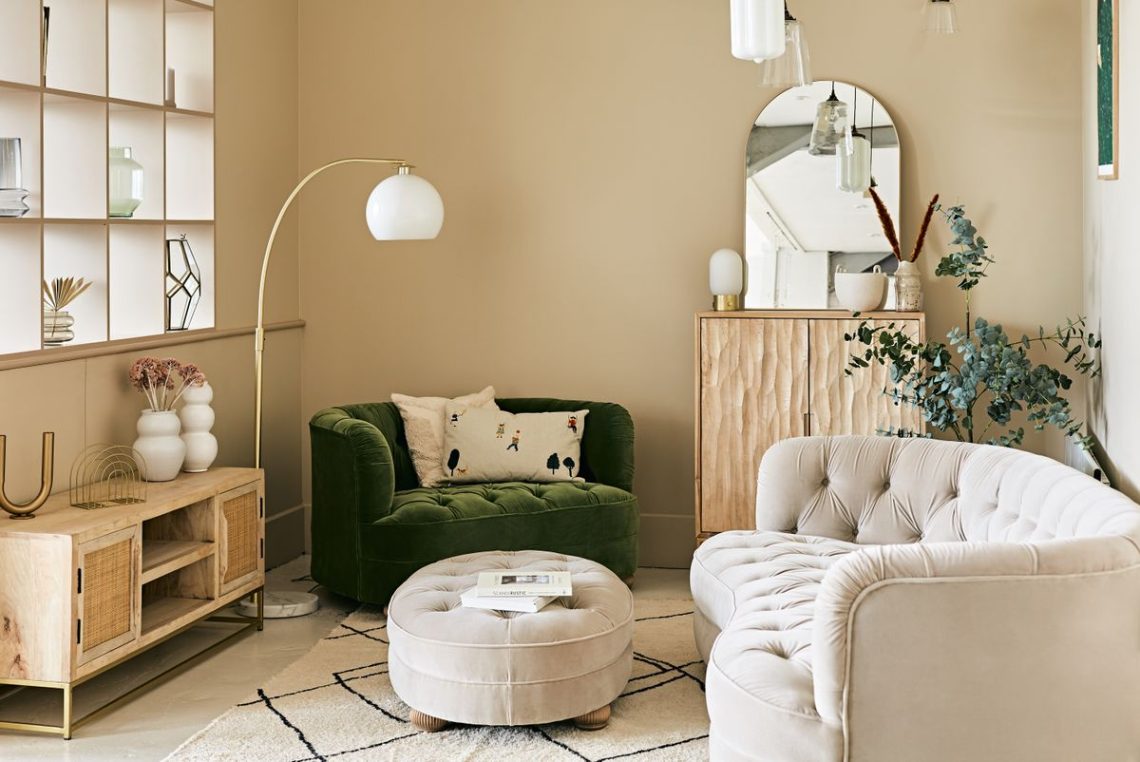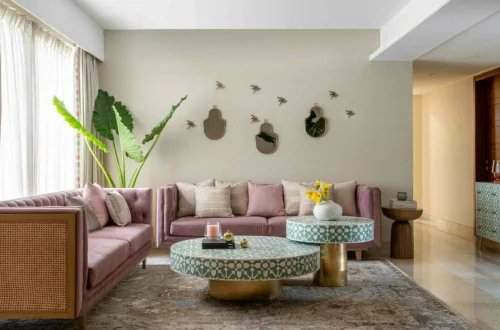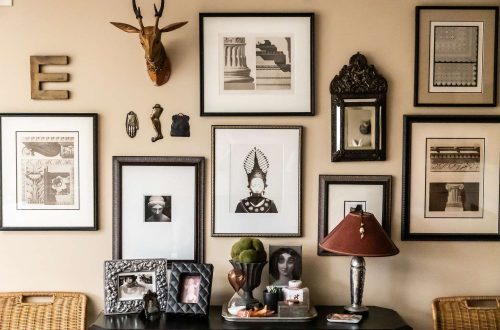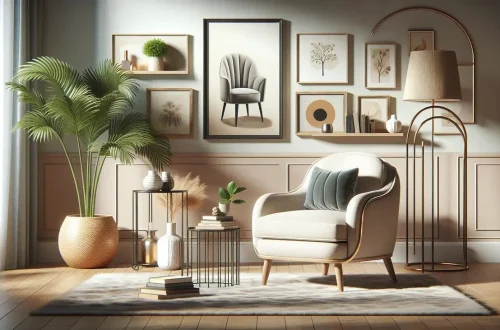We all know the common challenge of a small living room – wanting to create a comfortable, stylish space that doesn’t feel cramped or cluttered. The good news is that with a few smart design tricks, any small living room can feel open, airy, and stylish. The key is understanding how to use color, light, furniture placement, and accessories strategically to create the illusion of space. In this comprehensive guide, we’ll explore seven proven decorating techniques that will instantly transform your compact living area into a spacious haven that reflects your personal style and meets your functional needs.
Trick 1: Light Paint Colors & Tone-on-Tone Palettes
The most fundamental principle of making a small space feel larger is to use light colors. Light colors reflect more light, which makes a room feel brighter and more spacious. This doesn’t mean your living room has to be stark white – there’s a wide range of soft, warm tones that can achieve this effect while still providing personality.
Color Selection Strategies:
Choose colors that are just one or two shades lighter than your current walls. Off-whites, soft grays, pale blues, and warm beiges all reflect light while providing more character than pure white. Consider painting the ceiling a slightly lighter shade than the walls to create an illusion of height.
For a more sophisticated approach, use a tone-on-tone palette with different shades of the same color family. This creates visual interest without overwhelming the space. For example, pair soft gray walls with medium gray furniture and light gray accessories.
Pro Tip: Use the same light color on both walls and trim to create a seamless, expansive feeling. This eliminates visual breaks that can make a small room feel chopped up.
When implementing light colors, it’s important to maintain adequate lighting. Light colors work best when they’re well-illuminated, so combine ambient, task, and accent lighting to ensure your light walls don’t appear dull or flat.
Don’t forget to consider the color of your furniture and accessories. Light-colored furniture like white, cream, or pale woods can contribute to the spacious feeling, while dark furniture can make the same room feel smaller.
Trick 2: Furniture with Legs
One of the most effective ways to make a small living room feel larger is to choose furniture that sits on legs rather than solid pieces that sit flat on the floor. This design choice allows you to see more of the floor space, which creates an illusion of openness and makes the room feel less heavy.
Visual Impact: Furniture on legs allows light to flow underneath, creating a sense of continuity that makes the floor appear more expansive. This is particularly effective in rooms with interesting flooring like hardwood or patterned tiles.
Best Furniture Choices:
Sofas and Chairs: Choose pieces with exposed legs, whether they’re turned wood, metal, or another material. Mid-century modern designs often feature this characteristic and work particularly well in small spaces.
Coffee Tables: Glass or metal coffee tables on slender legs allow the floor to remain visible while providing the functionality you need.
TV Stands and Media Consoles: Instead of large entertainment centers that sit flat on the floor, choose credenzas or consoles with legs that create visual space underneath.
Balance Consideration: While furniture with legs generally makes rooms feel larger, ensure that the furniture is still proportional to the room size. Overly delicate furniture might look lost in a small space, while heavy furniture might overwhelm it.
Trick 3: The Power of Mirrors
Mirrors are perhaps the most effective tool in the small space decorator’s arsenal. By reflecting light and views, mirrors create the illusion of depth and can make a room feel significantly larger than it actually is. Strategic mirror placement can also enhance the room’s functionality by reflecting light into dim corners.
Strategic Mirror Placement:
Position mirrors directly across from windows to maximize light reflection. This is especially effective when the mirror can reflect views of greenery or interesting outdoor scenery, making it appear as though your living room extends into the exterior space.
Consider placing mirrors behind or near your primary seating area so that when you’re sitting, you see the reflection of the room from a different perspective. This creates depth and makes the space feel more expansive.
Creative Mirror Ideas: Use a large, floor-to-ceiling mirror as a statement piece that also serves the functional purpose of making the room appear larger. Alternatively, create a gallery wall using multiple smaller mirrors in varying shapes and frames for added visual interest.
Mirror Shape and Style:
Large mirrors generally provide more impact than multiple small ones, but a collection of smaller mirrors can work well when you want to avoid making the space feel too formal. Round mirrors can soften angular spaces, while rectangular or square mirrors work well in more structured rooms.
Consider frameless mirrors for a more contemporary look that doesn’t compete with other design elements for visual attention, or choose frames that complement your existing décor for a more cohesive appearance.
Trick 4: Go Big, Not Small
In a counterintuitive design choice that often surprises small-space decorators, using one large piece of art can feel less cluttered than displaying many small pieces. The same principle applies to other decorative elements like rugs. This approach reduces visual noise and creates a more impactful focal point.
Large Art and Decor:
Choose one large piece of artwork that takes up a significant portion of the wall space rather than cluttering walls with multiple small frames. A large painting, tapestry, or even a substantial mirror can become the room’s focal point while providing visual weight that doesn’t make the space feel crowded.
Similarly, invest in one substantial decorative object rather than several small knick-knacks. A large ceramic bowl, a sculptural piece, or an interesting plant in a statement planter will have more visual impact than a collection of small items.
Area Rugs:
Use one large area rug that extends under most of your furniture rather than a small rug that floats in the center of the room. The larger rug will anchor the furniture grouping and make the seating area feel more defined and substantial.
Choose a rug that’s large enough to have the front legs of your sofa and chairs on it. This creates a unified look that makes the space feel cohesive rather than small and scattered.
Pattern Consideration: Large-scale patterns in artwork or decor can make a small room feel more spacious than busy, small-scale patterns which can be visually overwhelming in compact spaces.
Trick 5: Multi-Functional Furniture
When square footage is at a premium, every piece of furniture should earn its keep by serving multiple purposes. Multi-functional furniture is not just a trend; it’s a necessity in small living rooms where storage and functionality are critical.
Storage Solutions:
- Storage Ottomans: These can serve as footrests, extra seating for guests, and hidden storage for everything from magazines to throw blankets.
- Coffee Tables with Drawers or Shelves: Keep living room essentials organized and out of sight while providing surface space for drinks and decorative items.
- Sofa Tables: These can provide storage while also creating a visual division in open-concept living spaces.
- Nesting Tables: These can be separated when you need multiple surfaces but pushed together to save space when not needed.
Convertible Furniture Options:
Consider a sleeper sofa if you occasionally host overnight guests, or a dining table that extends for special occasions but lives at a shorter length for daily use. A desk that can fold down from the wall when not in use can provide workspace without permanently taking up living room space.
Magazine racks that serve as small bookshelves, or decorative baskets that provide both storage and style, are excellent examples of multi-functional design.
Vertical Storage: Make use of wall space for storage with floating shelves or built-in units that provide storage without taking up floor space. This also helps draw the eye upward, creating an illusion of height.
Trick 6: Hang Curtains High and Wide
This simple curtain trick creates the illusion of taller, more spacious windows, which in turn makes the entire room feel larger and more elegant. The key is to think beyond the window frame and consider the entire wall as your canvas.
Proper Curtain Hanging:
Hang curtain rods about 6-8 inches above the window frame and extend them 6-8 inches beyond the frame on each side. This creates a wider frame around the window, making it appear larger and more architectural.
When possible, hang curtains as close to the ceiling as possible. This draws the eye upward and makes the ceiling appear higher, which is particularly effective in rooms with lower ceilings.
Fabric Considerations: Choose lightweight, flowing fabrics in light colors to maximize the expansive effect. Heavy, dark curtains can create the opposite effect, making the room feel smaller and more enclosed.
Color and Pattern:
For the most spacious effect, choose curtains in colors that are either slightly lighter than the wall color or the same color as the walls. This creates visual continuity rather than breaking up the wall space.
If you choose patterned curtains, ensure the pattern is not too busy or too large. Small-scale patterns that complement the room’s color scheme can add interest without overwhelming the space.
Trick 7: Use Clear Furniture
Acrylic or glass furniture pieces take up zero visual space, making them ideal for small living rooms. While they still physically exist, they don’t compete for visual attention like solid pieces might, creating an illusion of more open space.
Clear Furniture Options:
Glass Coffee Tables: These maintain the functionality of a surface for drinks and books while keeping the floor visually open beneath.
Acrylic Side Tables: These can provide surface space next to seating without adding visual bulk to the room.
Clear Seating: While less common, clear acrylic chairs can provide extra seating when needed without permanently altering the room’s visual balance.
Practical Consideration: Keep in mind that clear furniture shows dirt and fingerprints more than opaque furniture. Also, clear surfaces can look stark if not styled properly, so consider how you’ll accessorize these pieces.
Styling Clear Furniture:
Use a single, well-chosen decorative object on clear surfaces rather than cluttering them. A simple plant, a stack of carefully selected books, or a single piece of sculpture can provide visual interest without overwhelming the clear surface.
Ensure that what’s underneath clear furniture is as attractive as what’s on top. Since you can see through the furniture, what’s beneath becomes part of the overall design composition.
Maximizing the Effect of These Tricks
While each of these tricks can have a positive impact on a small living room, their combined effect is much greater than the sum of their parts. Understanding how to combine these techniques effectively will maximize the spacious feel of your room.
Creating Visual Flow:
Arrange furniture to create clear pathways through the room. Avoid pushing all furniture against the walls, which can make the space feel like a collection of furniture rather than a cohesive room.
Use a consistent color palette throughout the room to create visual continuity. This prevents the eye from being interrupted by stark color changes, which can make the space feel chopped up.
Light Distribution: Ensure that light is distributed evenly throughout the room rather than concentrated in one area. Multiple light sources at different levels (floor lamps, table lamps, overhead lighting) create a more spacious and welcoming environment.
Avoiding Common Mistakes:
While it might seem logical to use only small furniture in a small room, this can actually make the space feel cluttered with many small objects competing for attention. Instead, choose a few well-scaled pieces that fit the room appropriately.
Don’t be afraid to let some walls remain empty. Sometimes less is more, and the space between decorative elements can be just as important as the elements themselves.
Maintaining the Illusion of Space
Once you’ve implemented these space-enhancing tricks, maintaining them is crucial for preserving the spacious feel of your living room. Organization and maintenance play an important role in keeping a small space feeling open and uncluttered.
Organization Strategies:
Implement a “one in, one out” policy for new purchases. Before adding anything new to your living room, consider what you might need to remove to maintain balance.
Create designated homes for items that are frequently used in the living room. If things don’t have a proper place, they tend to accumulate on surfaces, creating visual clutter.
Regular Assessment: Periodically assess your living room to ensure that it maintains its spacious feel. What seemed like a good idea initially might not be working as well as you thought, and adjustments may be needed.
Seasonal Adjustments:
Be prepared to adjust your decor with the seasons. Heavy throws and multiple cushions might feel cozy in winter but can make a small room feel more cramped. Similarly, lighter, more minimal styling might be more appropriate in warmer months.
Conclusion
A small living room isn’t a limitation but rather an opportunity for creative, intentional design. By implementing these seven decorating tricks – from using light colors and furniture with legs to strategically placing mirrors and incorporating multi-functional pieces – you can create a living space that feels open, inviting, and perfectly suited to your needs.
Remember that the goal isn’t to make your furniture look tiny in a large room, but to create a sense of balance and proportion that makes the space feel both comfortable and spacious. This might mean choosing pieces that feel substantial enough to be functional while still maintaining the airy feel you’re looking for.
The key to success with small space decorating is to be intentional with every piece and design choice. Each element should serve a purpose, whether functional or aesthetic, and contribute to the overall goal of creating a space that feels larger than it actually is. With thoughtful planning and implementation, your small living room can become a beautiful, functional, and spacious retreat.
Don’t rush the process – finding the right balance takes time and experimentation. Be patient with yourself as you discover what works best for your specific space and lifestyle.





